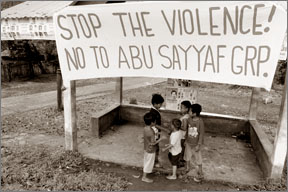Worst child abuse images quadruple online in three years
|

Children play at an empty military checkpoint with an anti-Abu
Sayyaf banner hanging from a waiting shed in Tagbak village in the
volatile island province of Jolo in southern Philippines Monday,
April 16, 2007. On Tuesday, April 17, 2007, police officials said
suspected Abu Sayyaf militants abducted seven workers at a
government road project on Jolo island. -AP
|
The number of images of serious child abuse online has quadrupled
over three years, according to figures from Britain's internet watchdog
published today.
The Internet Watch Foundation says the most distressing grade of
images account for nearly a third of all reports of child pornography it
receives.
The statistics paint a disturbing picture of growth in hardcore child
abuse pictures for sale online. In 2003, just 7% of the web pages
investigated by the group included the highest levels of abuse. Last
year the group says that 29% of all the images that its officers
investigated fell under the same classification, marking a fourfold rise
in the most disturbing cases.
Peter Robbins, the IWF's chairman, said the figures demonstrated an
increasing appetite among internet paedophiles for the most severe sorts
of imagery, while sites selling abusive pictures and videos appeared to
be turning to increasingly hardcore material in order to fend off
competitors.
"The images appear to be on a trend towards more severity, probably
because there is greater demand," Mr Robbins told the Guardian.
"The age of the children involved is predominantly under 12, and the
commercial sites where these images are being sold are staying up for
long periods."
Last year the IWF processed 31,776 reports of illegal images on the
internet - up from 24,000 in 2005. The material was hosted on more than
3,000 websites.
While less than 1% of the original material was traced back to
Britain, 82% of all the images it investigated were hosted on websites
in Russia or the US, creating serious fears over the possibility of
child trafficking and industrial-level abuse.
Home Office minister Vernon Coaker said although the figures were of
great concern, they represented "dramatic and continued progress" in
Britain's approach to online abuse. In recent years sentencing
guidelines have changed to longer terms for internet sex offences, and
those caught grooming children online now face up to 10 years in prison.
The IWF also operates a blacklist that prevents many web users from
accessing known abuse sites, although problems with overcrowded jails
have recently allowed some convicted of downloading child pornography to
avoid a custodial sentence. One expert said greater international
cooperation was needed to close down such websites completely.
"There's no doubt that half of the problem is the weakness of
international institutions," said John Carr, internet safety expert for
the children's charity NCH. "Interpol, Europol, the G8 and the UN could
all step up - but none of them have the political will."
Mr Robbins said that many of the sites were run by organised criminal
groups, and their other activities were often of greater concern to
police. The foundation, formed in 1997, is now the self-regulating body
in charge of finding and removing illegal images from the internet in
Britain.
Since it launched a decade ago with the support of the government,
law enforcement agencies and the internet industry, it has seen reports
of abusive images increase drastically.
Although much of the growth is down to the wider availability of the
internet in homes around the world, police investigating online abuse
are finding that criminals are discovering new ways to connect or
develop contact with each other.
"One of the sick things they'll do is film the abuse and actually
stick little notes on the child's body with the names of the other
person who they are sending it to," said Tom Simmons, intelligence team
leader at the Child Exploitation and Online Protection centre (Ceop), a
branch of the Serious and Organised Crime Squad dedicated to combating
child abuse. "Or sometimes you'll just see the kids saying 'Jan and John
say hi to whoever', and that's upsetting because you know that child is
going to get abused."
Although big chunks of police time have been dedicated to tracking
down those who download the images, police believe they must dedicate
more time to discovering the producers, not just the buyers and
distributors.
"What we've got to do is look at this like narcotics, in a way," said
Lewis Hunt, Ceop's intelligence group leader. "It's very easy to
concentrate on the consumers, but the difficulty is that we have to look
back at particular websites and people who are producing child abuse
images, and that is a really difficult thing to trace."
Earlier this year Ceop uncovered "one of the largest paedophile rings
in the world", with around 300 members worldwide, leading to the rescue
of eight children. In February it emerged that 29 Britons were under
investigation after Austrian police discovered 2,300 individuals using a
paedophile website based in Russia.
Guardian |
